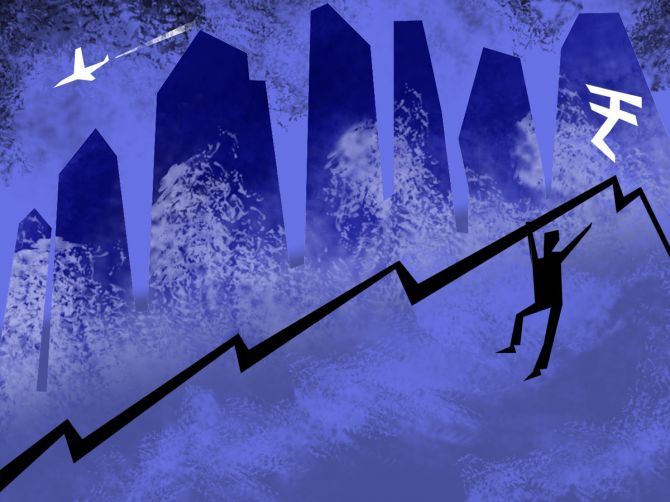''You can put 25 per cent right now; put another 25 per cent when Nifty corrects another 500 points.'
'At 13,500 put another 25 per cent and at 13,000 one can get fully deployed.'

Rusmik Oza, executive vice president, head of fundamental research, Kotak Securities, explains why the Indian equity markets fell by almost four per cent across the board -- the 30-stock bellwether Sensex fell 3.8 per cent, the 50stock Nifty crashed 3.76 per cent and the most volatile of them all, the Nifty Bank tanked 4.78 per cent -- following cues from the panic set by a rise in interest rate yields in US bond markets.
In this interview with Prasanna D Zore/Rediff.com, Oza reveals a simple strategy that investors could follow to earn 20-25 returns in the markets and gives his top five picks for investors with one-year and three-to-five year investment horizon.
"The markets are becoming good buy-on-dip markets. Between 13,000 and 14,000 would be a good place to accumulate. With this strategy the risk to reward ratio is in your favour," says Oza who is gung-ho about the Indian equity markets on the back of the government's solid capital expenditure plans, huge forex reserves to ward off any run on the Indian currency.
Why did the equity markets saw a sharp selloff on February 26?
The big spike in the US bond yields caused lot of nervousness in the global markets.
On January 1, the 10-year US G-Sec was around 0.91 per cent and in the last two days it spiked up to 1.47 per cent; intra-day it had spiked above 1.5 per cent as well.
The same 10-year G-Sec was hovering around 1.5 per cent pre-COVID and the fear is that if this crosses the 1.5 per cent inflection point then global investors would start seeing negatively at the equity markets because; if it crosses 1.5 per cent then it will head towards 2 per cent or so.
After the March 2020 panic, the 10-year G-Sec had hit a bottom of 0.5 per cent and now from that low it has spiked up substantially in 2021. This has led to the expectation that inflation globally is on its way up.
So, the rise in bond yields coupled with fear of global inflation is causing nervousness in the equity markets.
When bond yields go up, the bond PE multiple goes down and equity PE multiple also shrinks due to that.
Rise in bond yields will lead to some unwinding of carry trades also (of those investors who borrow the US dollars at very low rates and invest the proceeds in emerging markets looking for higher returns.
Rising interest rates in the US markets increases the risk to their investment in emerging markets and hence they sell); to square off the losses in the bond markets investors sell their equity portfolio in the emerging markets and money goes back to the US.
So, hardening US yields has an immediate impact on the inflows (FIIs get safer returns by investing in US G-Secs, so they reduce their exposure to emerging markets) and outflows (FIIs sell their emerging market portfolios, like in India, and move to US in search of better yields on their investment) and on local currencies also.
This further leads to selloffs in equities in emerging markets. That's what seems to have happened on Friday, February 26.
Against this backdrop, how do you look at the valuation of Indian markets? There have been concerns about overstretched valuations.
Do you think the US bond yield rising was just the trigger waiting to happen for valuations to correct?
In our December (2020) press conference we had observed that the biggest risk to Indian equity markets is the rise in US bond yields. Most of the other factors (apart from rise in US bond yields), as far as India is concerned, are favourable.
The other risk, as you mentioned, is the steep valuations.
As for US bond yields, our anticipation was they should have gone up in the second half of this calendar year.
But markets have somehow become super-efficient (or, could also be an indication of fear in the market about another Black Swan event) and they are discounting a lot of these risk factors much before they would do before (COVID-19 struck).
Based on Bloomberg estimate (of equity market analysts), the Nifty is trading (the price earnings, or, PE multiple) 21 times one-year forward (earnings).
When we gave our targets for calendar year, it was based on 19.5 times expecting that bond yields will increase in the second half and that will lead to moderation in valuations.
Maybe, there is some more scope for correction.
In the immediate term we could see a knee-jerk reaction due to these events but in the long-run India could stand among emerging markets because of three reasons.
We are going to see one of the sharpest V-shaped GDP recovery compared to any other emerging market economy.
We are likely to see sharpest jump in earnings in the next couple of quarters of FY22 (which begins April 1, 2021 and ends March 31, 2022) given that we were in one of the severest lockdowns since last March which impacted the earnings in quarters beginning March and June (of 2020).
The lockdown was lifted in phases and this saw some impact even on the quarter ending December (2020). But the earnings for quarters ending March (FY20-21), June, September (FY22) will be amazing in India and that will support our markets.
Pre-COVID and till now, we have added $110 billion to our forex reserves. These reserves gives the RBI a solid cushion to intervene in the markets to stem any untoward depreciation in the Indian rupee, as and when it deems it fit (the rupee fell by Rs 1.5, or 2.13 per cent, on February 26 against the US dollar and the market is expecting the RBI to intervene to stem further depreciation of the Indian currency).
These two cushions will provide enough support to the Indian (equity) markets at lower levels.
Now, after the Budget and the RBI's monetary policy, the only major trigger is the GDP number (for the October-December quarter; which was announced post this interview; Indian GDP for the third quarter ending December reported a year-on-year rise of 0.4 per cent).
Beyond these, the Indian markets will be at the mercy of global news flows and equity markets and are likely to correct further in the near future.
For the next couple of weeks we will be taking our cues from the global markets.
The net FII inflows in the Indian equity markets for the month of February stood at Rs 27,600 crore despite the selling seen in the last four days (this number was before the FII data for February 26 came in; the FIIs sold heavily to the tune of Rs 8,295 crore whereas DIIs bought Rs 1,450 worth of shares), which makes India a recipient of obscene FII inflows whereas all the other emerging markets have seen outflows.
My sense is, when the bond yields (in the US market) settle down, and if the GDP numbers turn out to be good then we could see some reversal; otherwise, there are two levels to watch out for: the 50-day (simple) moving average of Nifty is at 14,447 and we have closed just above that (on February 26).
We will have to see if this level holds next week. If we break this level and bond yield scare continues next week then we will be heading for 13,600.
What would you tell retail investors about how they should invest in the next two weeks given how choppy the Indian, and global, markets have been these past couple of weeks?
The markets are becoming good buy-on-dip markets. Between 13,000 and 14,000 would be a good place to accumulate.
Today's 13,000 level would be equal to 11,000 level six months back. So, investors would get the same market valuation at 13,000, which they saw six months ago at 11,000. The comfort level goes up if Nifty approaches 13,000.
India is likely to see very high growth in the next three-four years as we will enter a big investment cycle similar to what we saw between 2004 and 2008, thanks to the Budget because it has outlaid a huge capital expenditure; a lot of FDI is likely to come into India given the government's plans for privatisation of Indian PSUs, strategic disinvestment, and opening up the insurance sector with 74 per cent FDI limit.
This huge inflow will support the Indian currency and given the high-growth potential of the economy, FIIs will surely get attracted towards Indian equities. For them, wild currency fluctuation is a big concern, but given our forex reserves and plans to attract foreign capital the Indian currency is not expected to gyrate wildly.
The only worry, on the domestic front, would be a spike in COVID-19 cases given the rise in number of cases in states like Maharashtra and Kerala and the fear of its spread to other states.
If that happens, we will witness what happened in the US and Europe in the second wave and that could add to negative sentiment.
Talking about domestic negatives the yield on Indian 10-year G-Sec bond also jumped to 6.23 per cent on February 26.
Will that also act as a dampener in the context of the fact that the Indian government plans to borrow Rs 12 lakh crore next fiscal for its capital expenditure and the budgetary stance that outlines an uptick in fiscal deficit for the next three-four years?
We are expecting the yields could go up to 6.75-6.8 per cent in this calendar year. That could lead to a correction in Nifty's PE multiple from 22.4 to 20 times or even 19 times earnings.
In numbers, we could see another 10 per cent correction from the current level (of 14,500).
Is the market concerned about the spike in Indian bond yields? Are these concerns built into the current valuations?
Not fully, I think. Further adjustment will happen as we go ahead. It's (the correction in valuations) work in progress.
If I am a retail investor having Rs 100 to invest in the market at the current juncture then how should I go about doing it?
You (retail investors) can put 25 per cent right now; put another 25 per cent when Nifty corrects another 500 points. At 13,500 put another 25 per cent and at 13,000 one can get fully deployed.
I am not expecting Nifty to fall below 13,000 now.
The Bloomberg consensus target of Nifty today is 16,400, which is a 26 per cent upside from the 13,000 level.
Come Monday and retail investors can deploy 25 per cent of their investible money?
Yes, definitely.
At every 500 per cent drop one can keep deploying 25 per cent and that can continue till the Nifty reaches 13,000 at which level one can be fully deployed.
With this strategy the risk to reward ratio is in your favour.
What sectors look attractive to you now?
Our priority is very clear. You have to play the economic recovery sectors which were badly beaten since the pandemic began. They were the worst hit last year and they will be the ones reporting big jump in earnings as the recovery begins to mend itself.
We are very gung-ho on sectors like banks, oil & gas, construction, capital goods, engineering companies and metal companies.
What about the IT and pharma sectors?
We will avoid these two sectors because they have run up quite sharply during the pandemic when the economy got it. From here on they should go through some de-rating process.
Both the BSE IT and BSE Pharma indices have given a breakdown (have gone below crucial supports on the downside) and so will avoid them for now.
One can look at selective plays in the FMCG sector, but then again this sector did see good growth during the lockdown. If the FMCG index corrects by another 10 per cent then one can look at selective stocks in this sector.
IT and pharma can be avoided now given their huge outperformance during the pandemic.
What are the top five picks one can go for with one-year and with three-five year investment horizon?
Top five picks:
With one-year investment horizon:
- SBI Life Insurance
- L&T
- Bharti Airtel
- Kalpataru Power
- Coal India
This basket can give returns of 25-30 per cent in the next year or so.
With three- to five-year investment horizon:
- L&T
- Reliance Industries
- SBI Life Insurance
- ICICI Bank
- Hindustan Unilever
This basket can give returns of 20-25 per cent in the next three to five years











 © 2025
© 2025